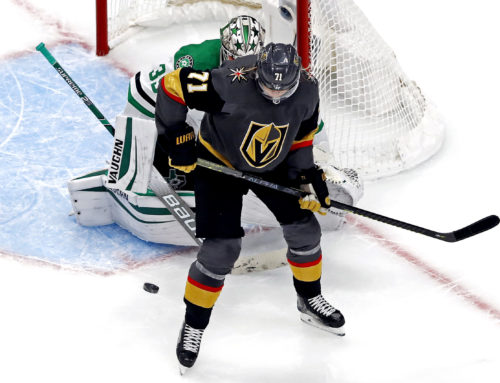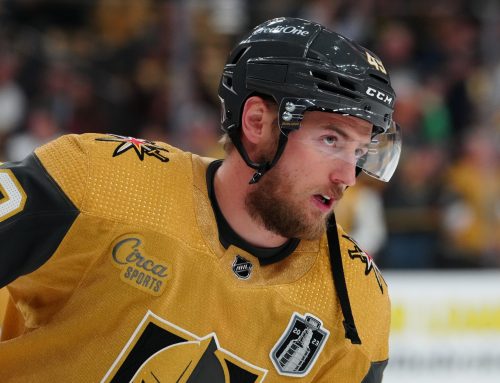Frozen Tool Forensics: Breakout Threshold Roundup
Chris Kane
2024-04-19
Back in August we spent some time digging into players that might have been positioned to break out based on their 2022-23 seasons. Now that NHL action is essentially wrapped (writing this on Thursday, April 18th), it is time to look in the rear view mirror and see how that list of players performed.
As a little reminder, this piece is loosely based on some work on breakout thresholds. The full article was posted on June 30th, 2022 and is a good read so definitely go check it out. The brief summary is that there tends to be a game count by which players start to break out. In this case breakout is defined as a 25 percent year-over-year increase. What they found is that average size forwards need about 200 games, and both defencemen & exceptionally small, or larger forwards need about 400 games. Please go check it out for more details, but one section in particular caught my attention.
"It’s always a great indicator if you see that a player finishes the previous season with 230 or 240 career games and he just enjoyed a very strong second half. When you see that, then feel confident in a potential breakout for the year ahead."
That got me excited because these are a couple of variables that we can easily filter and sort for (height being a bit more of a challenge in our current report options). With the right table or reports we can pull this information together and get a list of players who meet this criteria. According to this research it should be a list of players poised to do good things next year. The article also makes clear that these are all generalities, and there are definitely exceptions, but it made me very interested to see who might be on this list.
Once I exported the reports with the data I needed I combined them for a custom table for filtering. After applying the games played and point pace criteria we got a list of six names.
| Name | Pos | 23-24 Team | Career GP | 22-23 Second Half 82GP Pace | 22-23 First Half 82GP Pace | Δ in Splits | 22-23 Full Season Pace | Projected 23-24 Pace |
| SAMMY BLAIS | L | STL | 204 | 46 | 12 | 34 | 29 | 36 |
| KIRBY DACH | C | MTL | 210 | 64 | 48 | 16 | 54 | 68 |
| EETU LUOSTARINEN | L | FLA | 212 | 48 | 38 | 10 | 43 | 54 |
| MICHAEL RASMUSSEN | L | DET | 238 | 49 | 39 | 10 | 42 | 53 |
| TIM STUTZLE | C | OTT | 210 | 97 | 89 | 8 | 95 | 119 |
| JACK HUGHES | C | N.J | 244 | 108 | 100 | 8 | 104 | 130 |
It was an interesting group because several of the players didn't even pan out to be sure thing fantasy relevant choices. Looking at you Sammy Blais, Eetu Luostarinen, and Michael Rasmussen. That left Kirby Dach, Tim Stutzle and Jack Hughes. Hughes and Stutzle were kind of already there (a bit like Tage Thompson the year before) and it wasn't entirely clear if they had another level to ascend to or if this was their breakout season. That sort of left Kirby Dach as a pretty strong candidate for both a fantasy relevant and potentially improved 23-24. The caveat at the time though was he was going to need top line deployment, and to avoid getting injured.
So how did our group do in 23-24? I am turning to Frozen Tool's Big Board report to find out.
| Name | Pos | 23-24 Team | 22-23 Full Season Pace | Projected 23-24 Pace | 23-24 GP | 23-24 Actual 82G Pace |
| SAMMY BLAIS | L | STL | 29 | 36 | 52 | 11 |
| KIRBY DACH | C | MTL | 54 | 68 | 2 | 82 |
| EETU LUOSTARINEN | L | FLA | 43 | 54 | 82 | 27 |
| MICHAEL RASMUSSEN | L | DET | 42 | 53 | 75 | 36 |
| TIM STUTZLE | C | OTT | 95 | 119 | 75 | 77 |
| JACK HUGHES | C | N.J | 104 | 130 | 62 | 98 |
Let's just say it was not a banner year for the process. Last summer, at the end of the 22-23 season when we did the look back review we saw about half of the potential candidates improved their point paces from 21-22 with about a quarter of them hitting the actual 25 percent threshold established for a breakout. This year no one came close to the 25 percent increase projection. Jack Hughes came the closest to matching his 22-23 pace, but certainly did not increase it. Essentially everyone else dropped (we will get to Dach in just a second).
What can we learn here? Well let's take a few names here and review what happened.
Sammy Blais made the list because he had close to the right game count and was coming off of his strongest end of season to date. He got there by being traded to a new team, getting 14 and a half minutes of total time, and about a third of the power-play time on a kind of devastated (personnel wise) St. Louis offense. Oh and he had a 22 percent shooting percentage. Going into the season he wasn't projecting into the top six or in a decent power-play spot so it maybe isn't much of a surprise that he didn't maintain that strong second half. In fact, he lost about five minutes of overall ice time, and essentially all of his power-play time. And he had a three percent shooting percentage.
Michael Rasmussen had a very similar story. He didn't change teams, but from mid-December on he was getting about 16 minutes of ice time on average playing largely with David Perron and Dylan Larkin, or Andrew Copp. He put up reasonable stats during that time, but fast forward and Detroit adds a couple of top six wingers in Alex Debrincat and Patrick Kane and all of a sudden instead of growing in opportunity he is down in the bottom six maxing out around 15 minutes most nights.
Starting in mid-January of 2023 Eetu Loustarinen was getting some great deployment next to Matthew Tkachuk and either Carter Verhaghe or Anton Lundell, averaging about 16 and a half minutes a night. Fast forward to 22-23 and he is very solidly in a third line role with Anton Lundell and either Nick Cousins or Evan Rodrigues.
What is the theme with all three of these players? These were guys that had solid second halves due to increased deployment that then did not sustain into 23-24. In large part it was actually kind of predictable as there were team circumstances that led to those increased roles being less likely going forward.
That leaves us with Hughes and Stutzle. Hughes was pretty close to matching his 22-23 pace, but we might have expected a bit more. He did see more time on ice, both at even strength and on the power-play. He did maintain his shot rates, but most of his underlying numbers were a bit down. His personal and team shooting percentages, plus his point participation rates were lower than in 22-23. That holds true for Stutzle as well, pretty big drops in shooting percentage and some of his other metrics, but the difference there is that Stutzle was also a little less dangerous overall (as measured by expected goal numbers).
Finally we have Dach whose pace looks excellent, but he only played two games. We just have to put a big old NA or asterisk next to his name when looking at this data and maybe see what happens next year.
For general takeaways? Hughes and Stutzle were always a long shot to increase by another 25 percent, but should have been able to hit closer to or improve on their 22-23 seasons. Part of the puzzle there definitely appears bad luck with slight drops in underlying metrics that tend to fluctuate a bit each season. For the other three borderline candidates this year just emphasizes the point. Part of this breakout threshold discussion is about a player's personal growth and increased ability, but a big part of it is also deployment. Does the coach trust them yet? How does the coach play them? When does a coach see enough development in a player to trust them in a top six and decent power-play role? For these three the answer was clearly not quite yet.
That is all for this week
Do your part to support organizations working to make hockey for everyone.





 TOR
TOR BOS
BOS EDM
EDM DAL
DAL OTT
OTT VGK
VGK VAN
VAN WPG
WPG CAR
CAR
